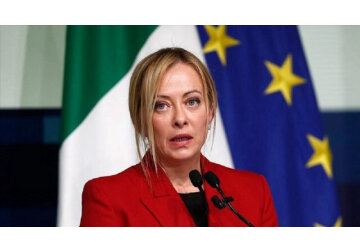
Italy at Cusp of EU’s Deficit Cap Awaits Last Push by Meloni
Giorgia Meloni’s annual budget this week is set to reveal just how soon Italy can conform again to European Union rules, in the crowning fiscal achievement of her premiership so far. The plan to be unveiled in coming days will show the country’s deficit back below the bloc’s 3%-of-output ceiling by next year at the latest, with the tantalizing prospect that even the 2025 shortfall could come in under that threshold. Such an outcome is “possible,” Finance Minister Giancarlo Giorgetti said earlier this month, while cautioning that the results depend on Italy’s economic performance in the final quarter. Officials have described that hope as a touch-and-go matter in the drafting of the budget in recent weeks, according to people familiar with the matter. However it turns out, the deficit path will be a standout feature of the 2026 plan to be signed off by Meloni and her cabinet, incorporating a program that seeks to deliver tax cuts to the middle classes even as Italy’s economy struggles to eek out much growth. After approval by ministers, the budget will be presented to Parliament. Italy hasn’t run a deficit below 3% since 2019, before the pandemic struck. Even achieving it next year would be earlier than it had once forecast — an accelerated timetable that contrasts markedly with France, which is set to remain above that limit for years to come amid extended political strife. What Bloomberg Economics Says... “Italy’s brighter fiscal picture has come at the cost of a higher tax burden on workers. As the country faces the need to consolidate public finances, it remains uncertain whether today’s elevated tax revenues can be sustained. Fiscal policy should focus on strengthening compliance and improving spending efficiency, while tackling structural weaknesses — particularly the extensive and often inefficient system of tax expenditures.” —Simona Delle Chiaie, chief euro-area economist. For full research, click here Even without knowing the final numbers, Fitch Ratings was impressed enough by Italy’s progress to deliver its first upgrade of its credit score since 2021 this month, just one week after it cut France. Other rivals could deliver accolades of their own in coming weeks. Complying with the EU limit this year already would allow Italy to exit the bloc’s excessive deficit procedure, which in turn would permit an expansion of the country’s defense spending. That’s a key point as Italy, along with its other NATO allies, has committed to raising defense spending to 5% of GDP in order to satisfy demands by US President Donald Trump. Meloni’s apparent Italian miracle is being helped by considerably lower borrowing costs, partly driven by investors cheered at the unusual stability of her premiership and her government’s steady efforts at fiscal repair. Spreads between 10-year Italian bond yields and those of Germany are currently close to 80 basis points, less than a third of the level when Meloni took office in 2022. Officials preparing the budget were assuming about €5 billion ($5.9 billion) in lower borrowing costs this year and a possible €8 billion next year should conditions remain the same, people familiar with the matter said earlier this month. Another boon has been stronger revenues. That latter effect has benefited from fiscal drag as inflation brings taxpayers into higher income brackets — an issue Meloni and Giorgetti are trying to rebalance by lowering the rate imposed on people earning between €28,000 and €60,000 a year. Consumer-price growth has at least slowed from a peak of above 12% in 2022. It was at 1.8% in September, marking its fifth month below the European Central Bank’s 2% target, according to data released on Tuesday. The gloss of Italy’s deficit numbers may obscure less impressive truths. Debt remains huge, at more than 130% of gross domestic product, and growth is distinctly lackluster. Expansion is likely to slow to 0.6% from last year’s 0.7%, and may not expand much more in 2026, the people said. US tariffs are one challenge there, and Germany’s weakness is another. Europe’s biggest economy is Italy’s main trading partner, and may struggle to grow much in 2025. Italy was previously initially anticipated to expand 1.2% this year — or double the current expected increase. That’s put a damper on some of Meloni’s other ambitions, such as more pronounced tax cuts and a revamping of fiscal brackets. It may limit the amounts set aside for other measures, including help with housing for young couples and tax breaks for companies that invest and hire. The budget this week will also reveal if her coalition has opted to increase revenue by alternative means, including raising an extra €3 billion from Italian lenders though schemes such as a further postponement of their tax deductions. bloomderg.com







